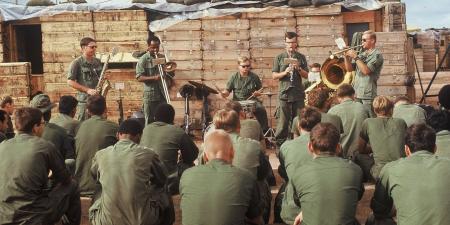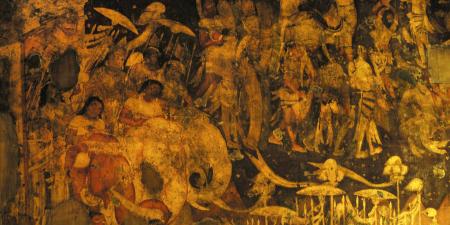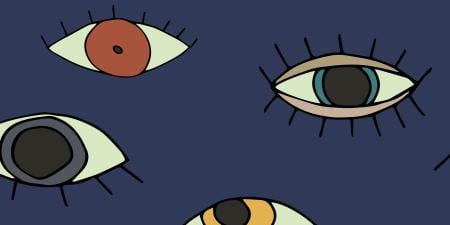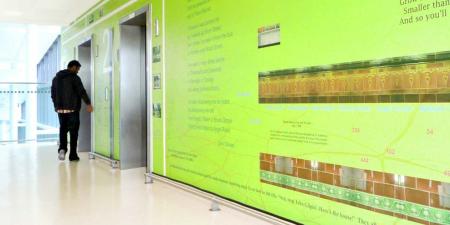Abstract
Background: Arts-based activities’ roles in medical education is to challenge students to cultivate clinical skills using ART (aesthetics, reflection, time). ART activities offer opportunities for students to cultivate creative dimensions of their clinical skills and to reflect on their responses to uncertainty and ambiguity. Faculty, however, are challenged to structure these learning activities in diverse, sometimes unfamiliar, health care settings.
Methods: This study explored preclerkship medical students’ responses to participating in ART activities presented in the common medical educational format of an objective structured clinical exam (OSCE). Activities included interpreting fine art (eg, images and poetry) and drawing a simulated patient. The discussion section transcript and student sketchbooks were analyzed to identify themes related to participating in the study.
Results: Use of arts-based activities elicited behaviors similar to those observed in students’ responses to formal summative OSCEs, although students also wrestled with challenges and expressed their subjective impressions.
Conclusions: This study offers an arts-based tool set capable of being delivered within the familiar medical education setting and established structure of the OSCE.
Introduction
It has been challenging for medical educators to devise and assess arts-based activities that medical students recognize as clinically relevant.1,2,3 Arts-based activities in venues outside the student’s traditional learning environment, such as a museum or gallery, offer little contextual significance for learners. The importance of setting and environment in learning has gained growing recognition in medical education,4,5 as learners are socialized to demonstrate requisite skills and model behaviors within the clinical and learning contexts.6,7 It could be argued that, in order to pass standardized examinations, first- and second-year students adopt model behaviors that are without meaning for them and with no understanding of how the behaviors are relevant and critical to practice.
The objective structured clinical examination (OSCE) is an integral part of medical training and is regarded as an effective assessment instrument in terms of the types of skills and number of tasks that can be assessed.8 Learners must demonstrate competence in a series of fixed-interval simulated scenarios with standardized patients (SPs), observed by an assessor. Although the OSCE is considered a standardized assessment of clinical interactions, some feel it is limited in its capacity to assess the cultural, subjective, and sociopolitical contexts that permeate clinical interactions.9 The OSCE deconstructs the patient-physician interaction by assessing discrete and isolated aspects of a complete clinical encounter and is stressful for learners.10
The application of the arts in this setting could nurture fresh thinking, challenge assumptions, and engender critical reflection on socially relevant aspects of medicine and clinical care.11 Previous studies have shown that spending time with works of art can cultivate students’ critical thinking, identification of stories and narratives, emotional recognition, empathy, and awareness of multiple perspectives.12,13,14,15 The journey of both the artist and the physician requires attention, reflection, critical questioning, and openness to the value of new and sometimes uncomfortable or unfamiliar perspectives or worldviews.16,17 The Aesthetic Reflection Time (ART) of OSCE is a qualitative study using arts-based activities within an OSCE setting. We explored and observed participants’ behaviors and responses to the different arts-based activities in the familiar clinical examination environment. The experiences were designed to promote participants’ awareness of their thoughts and feelings related to the nature and demands of the OSCE process and space.
This innovative pilot study provides the basis for dialogue about implementing aesthetics—as an art-based tool set—in the established structure of the OSCE. This critical and transferable tool set could facilitate reflection on the nature of clinical interactions and decision making, thus contributing to a more holistic and reflective OSCE experience.
Methods
Participants. We recruited a convenience sample of 8 preclerkship (first- and second-year) medical students attending Dalhousie University in Halifax, Nova Scotia, Canada. All activities took place at the Centre for Collaborative Clinical Learning and Research at Dalhousie University, a clinical skills and examination setting familiar to the students.
Design. The study consisted of 4, 1-hour sessions in a single day. Prior to starting the sessions, the first author (M.G.) introduced all 8 participants to the study activities. The session activities are outlined in Table 1.
| Session | Description |
|---|---|
|
1 |
As a single group, M.G. and the students discussed and analyzed selected visual artworks, enabling participants to hear others’ perspectives as well as articulate their own thoughts in response to each image. |
|
2 |
Participants were given a sketchbook and drawing materials and made a series of short drawings of each SP. Participants were encouraged to work without the goal of getting the “right answer” to ensure their resultant pen drawings were rendered with acute observation and created with attention and feeling. |
|
3 |
Participants were given a sketchbook and drawing materials and divided into 2 groups that rotated through a set of 4 OSCE stations. As in an actual OSCE, they spent 10 minutes at each station. Activities included reflecting on actual drawn and painted portraits hung on the walls of 2 stations, reflecting on a poem that was pinned on the wall of a third station, and, finally, drawing an SP who manifested a condition or ailment. Similar to a regular OSCE, students prepared themselves for each task beforehand by reading “candidate instructions” that were pinned on the door outside each station. |
|
4 |
M.G. and the second author (L.P.) led a follow-up discussion with participants, which was recorded and transcribed. |
|
Abbreviations: OSCE, objective structured clinical examination; SP, simulated patient.
|
|
Analysis. Qualitative analysis of the transcribed discussion section and of participants’ sketchbooks, which consisted of their written reflections on the artworks and poem and their drawings of the SPs, was carried out by the authors. The analysis focused on what participants’ drawings, interpretations, reflections, and written and verbal comments revealed about their experience of taking part in the study. In order to identify themes, the analysis team used an immersion-crystallization process in which reading and rereading the data was interspersed with ongoing iterative discussions of findings from multiple perspectives.18
Results
The 3 main themes that emerged from the analysis and examples of each theme are shown in Table 2.
| Theme | Behaviors Exemplifying Theme |
|---|---|
|
Participants adopted the same behavior they would have in an OSCE |
• Prior to entering the room, taking extensive notes about the task from the instructions pinned to the door |
| Participants were challenged by ambiguities, uncertainties, and silence |
• Voicing curiosity and skepticism |
| Participants expressed their subjective impulses, reflections, interpretations, and imaginings |
• Interpreting metaphors and imagery |
|
Abbreviations: OSCE, objective structured clinical examination; SP, simulated patient.
|
|
Exemplifying the first theme in table 2, the behaviors adopted by the participants mirrored those observed in their typical OSCE counterparts. In particular, when entering the fourth station with the SP, participants initially chose to try to establish rapport with the SP by requesting permission to begin the drawing. This behavior also parallels what would be expected from a clinician in a medical interaction when taking a history or carrying out a physical examination on a real patient. Because participants perceived the parallel between drawing the SP and their previous OSCE experience with SPs, they felt they could more readily “engage” with this station than others.
As an example of theme 2, participants wrestled with how the arts could inform their understanding of medicine. One participant stated: “I enjoy medicine and I enjoy art…. I wasn’t really sure how those could be collaborated together, other than just like drawing organs or whatever.” Another participant noted that, although “composing yourself is very valuable,” sitting in silence would be “a waste of time in a real OSCE.” Given their prior experience, sitting alone in silence was challenging. A third participant wrote: “I’m here, I need to say something soon or else I don’t know what. Or else it looks bad or something.” For others, drawing the SP felt like a distraction. A fourth participant reflected: “It was challenging … trying to juggle the different things we were trying to do.” Yet another participant observed that drawing “seems like an intimate thing … like you wouldn’t just start doing it. It’s too private.” In a regular OSCE, students must introduce themselves and explain the boundaries of the interaction. Receiving no verbal consent from the SP to be drawn was disconcerting to this participant: “So I just kind of tried to get comfortable with the silence…. One thing I’m working on even in med school is trying to not fill the void with my random rambling.”
As an example of the third theme, viewing the paintings and drawings prompted curiosity and a desire to know more about the individuals portrayed. One participant wrote: “I feel like I want to know each person’s story; they each look like they have interests unique to them.” The poem also encouraged participants to engage with the aesthetic values of rhythm and tone. Another participant reflected: “This is the only station that brought me out of the clinical setting and made me lose what I was doing and taking part in.”
Discussion
Immersing oneself in works of art can develop emotional responses, provide alternative forms of representation, and promote dialogue and sharing of stories in ways that parallel the interpersonal and diagnostic challenges experienced in clinical interactions.14 As medicine has become more collaborative and patient centered, greater appreciation of the patient’s subjective health and illness experience is required, yet is often secondary to the objective and clinical components of evidence-based medicine.19 Arts-based activities have been shown to effectively address competencies related to a more patient-centered, empathic, and holistic approach to care.20,21
The ART of OSCE sought to develop a space for engendering more reflective and creative processes, where students could reflect not just on their interpretations of the SP or artwork but on how these activities related to their prior OSCE experience. Learners used the familiar ritualized OSCE behaviors, such as knocking on the door and taking notes from the instructions, even when those behaviors did not apply in this study. They oscillated between what they had learned previously and the more improvisational and creative impulses they were being encouraged to act on during the study. They felt vulnerable outside the comfort zone of performing familiar tasks, yet the complexities of medicine require an openness to the unexpected, ambiguity, and uncertainty.
Conclusions
The structure of the traditional OSCE may result in learners focusing on demonstrating competence rather than having an authentic connection to SPs and to clinical practice. This study provides the basis for developing an arts-based tool set that could be incorporated into clinical skills assessment. The study has several limitations, however. The number of students was small, but in an in-depth, qualitative exploratory study there is no defined number of participants. Moreover, only students from one campus participated due to timing. It is uncertain whether the results would have been similar with a second group of students at the same level of training. Future research could examine how this tool set could augment assessment of the relational, moral, and ethical aspects of medicine within the OSCE setting. The impact of the tool set on learners’ ability to make relevant connections to critical aspects of their medical education could also be explored.
References
- Shapiro J, Coulehan J, Wear D, Montello M. Medical humanities and their discontents: definitions, critiques, and implications. Acad Med. 2009;84(2):192-198.
- Macneill PU. The arts and medicine: a challenging relationship. Med Humanit. 2011;37(2):85-90.
-
Moniz T, Golafshani M, Gaspar CM, et al. How are the arts and humanities used in medical education? Results of a scoping review. Acad Med. Published online April 6, 2021.
- Miles S, Leinster SJ. Medical students' perceptions of their educational environment: expected versus actual perceptions. Med Educ. 2007;41(3):265-272.
- Schrewe B, Ellaway RH, Watling C, Bates J. The contextual curriculum: learning in the matrix, learning from the matrix. Acad Med. 2018;93(11):1645-1651.
- Cruess RL, Cruess SR. Expectations and obligations: professionalism and medicine's social contract with society. Perspect Biol Med. 2008;51(4):579-598.
-
Byszewski A, Gill JS, Lochnan H. Socialization to professionalism in medical schools: a Canadian experience. BMC Med Educ. 2015;15:204.
- Mitchell ML, Henderson A, Groves M, Dalton M, Nulty D. The objective structured clinical examination (OSCE): optimising its value in the undergraduate nursing curriculum. Nurse Educ Today. 2009;29(4):398-404.
- McGrath P, Anastasi J, Fox-Young S, Gorman D, Moxham L, Tollefson J. Collaborative voices: ongoing reflections on nursing competencies. Contemp Nurse. 2006;22(1):46-58.
- Allen R, Heard J, Savidge M, Bittergle J, Cantrell M, Huffmaster T. Surveying students' attitudes during the OSCE. Adv Health Sci Educ Theory Pract. 1998;3(3):197-206.
- Kumagai AK, Wear D. “Making strange”: a role for the humanities in medical education. Acad Med. 2014;89(7):973-977.
- Housen AC. Aesthetic thought, critical thinking and transfer. Arts Learn Res. 2002;18(1):99-132.
- Klugman CM, Peel J, Beckmann-Mendez D. Art rounds: teaching interprofessional students visual thinking strategies at one school. Acad Med. 2011;86(10):1266-1271.
- Schaff PB, Isken S, Tager RM. From contemporary art to core clinical skills: observation, interpretation, and meaning-making in a complex environment. Acad Med. 2011;86(10):1272-1276.
-
Lyon P, Letschka P, Ainsworth T, Haq I. An exploratory study of the potential learning benefits for medical students in collaborative drawing: creativity, reflection and “critical looking.” BMC Med Educ. 2013;13:86.
-
Macnaughton RJ, Evans HM. Why pay attention to the artist? Med Humanit. 2005;31(1):1-2.
- Macnaughton J. The humanities in medical education: context, outcomes and structures. Med Humanit. 2000;26(1):23-30.
-
Borkan J. Immersion/crystallization. In: Crabtree B, Miller W, eds. Doing Qualitative Research. Sage Publications; 1999:174-194.
- Macleod A, Frank B. Patient-centredness in a context of increasing diversity: location, location, location. Med Teach. 2010;32(10):799-801.
-
Centeno C, Robinson C, Noguera-Tejedor A, Arantzamendi M, Echarri F, Pereira J. Palliative care and the arts: vehicles to introduce medical students to patient-centred decision-making and the art of caring. BMC Med Educ. 2017;17:257.
- Zazulak J, Halgren C, Tan M, et al. The impact of an arts-based programme on the affective and cognitive components of empathic development. Med Humanit. 2015;41(1):69-74.



